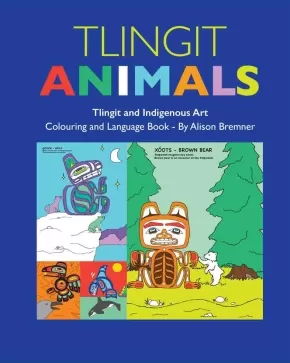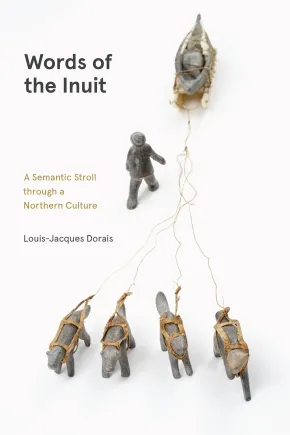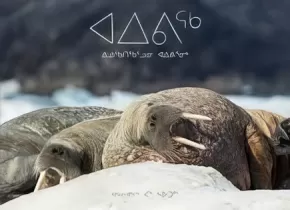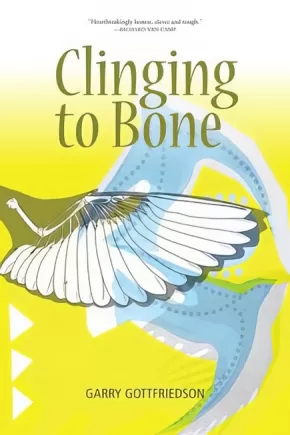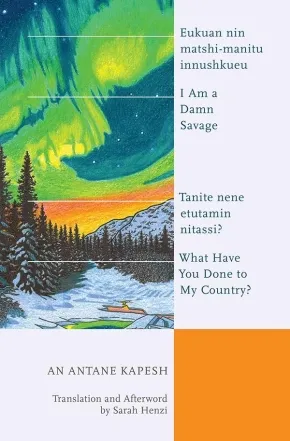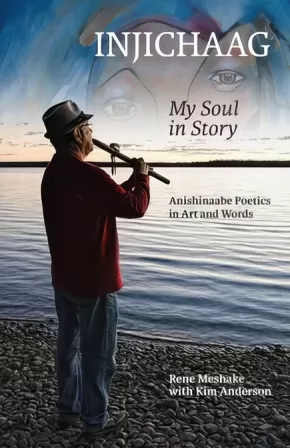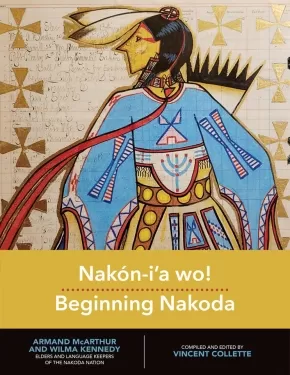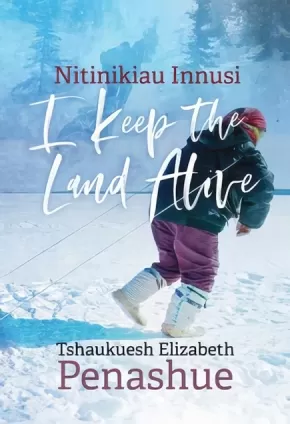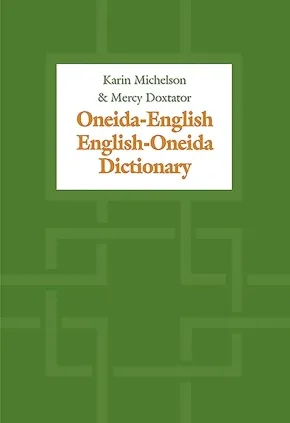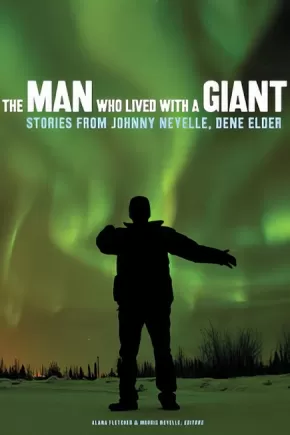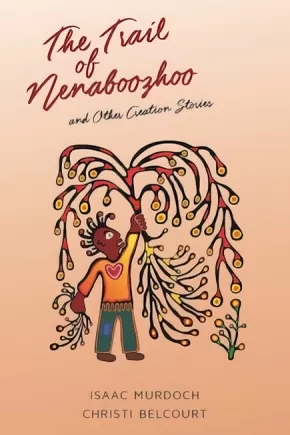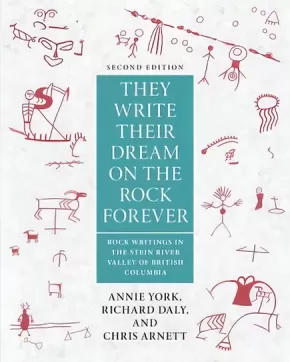
Language
61
-
75
of
123 Results;
Sort By
Go To
of 9
Tlingit Animals: Tlingit and Indigenous Art Colouring and Language Book
$9.00
Artists:
Format:
Paperback
Text Content Territories:
Indigenous American; Alaska Native; Tlingit;
ISBN / Barcode: 9781554766239
Synopsis:
Synopsis:
Alaskan Alison Bremner reclaims her ancestral language in this Tlingit coloring book featuring her original art. Alongside each drawing, each animal is identified by their English and Tlingit names. The English and Tlingit sentences below explain each animal’s cultural significance. Tlingit Animals is intended to teach younger generations Tlingit culture and language, in addition to developing reading skills and creativity.
Educator Information
24 pages colouring and language book Tlingit Indigenous Art
Printed in Canada
Additional Information
24 Pages
Words of the Inuit: A Semantic Stroll through a Northern Culture
$31.95
Format:
Paperback
Text Content Territories:
Indigenous Canadian; Inuit;
Grade Levels: University/College;
ISBN / Barcode: 9780887558627
Synopsis:
Synopsis:
Words of the Inuit is an important compendium of Inuit culture illustrated through Inuit words. It brings the sum of the author’s decades of experience and engagement with Inuit and Inuktitut to bear on what he fashions as an amiable, leisurely stroll through words and meanings.
Inuit words are often more complex than English words and frequently contain small units of meaning that add up to convey a larger sensibility. Dorais’ lexical and semantic analyses and reconstructions are not overly technical, yet they reliably evince connections and underlying significations that allow for an in-depth reflection on the richness of Inuit linguistic and cultural heritage and identity. An appendix on the polysynthetic character of Inuit languages includes more detailed grammatical description of interest to more specialist readers.
Organized thematically, the book tours the histories and meanings of the words to illuminate numerous aspects of Inuit culture, including environment and the land; animals and subsistence activities; humans and spirits; family, kinship, and naming; the human body; and socializing with other people in the contemporary world. It concludes with a reflection on the usefulness for modern Inuit—especially youth and others looking to strengthen their cultural identity —to know about the underlying meanings embedded in their language and culture.
With recent reports alerting us to the declining use of the Inuit language in the North, Words of the Inuit is a timely contribution to understanding one of the world’s most resilient Indigenous languages.
Reviews
"Professor Dorais once again provides expert information and insight into the Inuit language and culture as only he can. This book is written so that academics, Inuit and the public can all learn more about the people who live in Canada’s most northern region. By examining the rich meanings contained within words of Inuktitut, Dorais details social nuances and core aspects of both traditional and modern Inuit culture.”— Alana Johns
Educator Information
Table of Contents
Introduction: Words from the Past, A Stroll Through Inuit Semantics
Ch. 1: Words for Speaking About the Environment and Land
Ch. 2: Words for Speaking About Animals and Subsistence Activities
Ch. 3: Words for Speaking About Humans and Animals
Ch. 4: Words for Speaking About Family, Kinship, and Naming
Ch. 5: Words for Speaking About the Human Body
Ch. 6: Words for Socializing in the Contemporary World
Conclusion: Words for the Future
Additional Information
344 pages | 6.00" x 9.00" | 2 maps, 2 figures, bibliography
Aiviq (Inuktitut): Life With Walruses
$27.95
Artists:
Format:
Paperback
ISBN / Barcode: 9781772272024
Synopsis:
Synopsis:
Massive, elusive, and always deserving of respect, the walrus is one of the Arctic’s most recognizable animals. For thousands of years, Arctic residents have shared the coastlines and waters of the Arctic with these huge beasts. Often misunderstood by people who have not had first-hand encounters with them, walruses are known to those who share their habitat as somewhat unpredictable creatures, always deserving of caution when encountered. From close encounters with angry walruses, bent on destroying boats and chasing off humans to witnessing the attentive care of a walrus mother with its calf, this book gives readers from outside the Arctic a first-hand look at what life alongside walruses is really like.
Aiviq: Life with Walruses features stunning wildlife photography by acclaimed photographer Paul Souders accompanied by first-hand accounts from people living alongside this enormous sea mammal.
Educator Information
This book is entirely in Inuktitut.
Additional Information
|
Clinging to Bone (2 in Stock)
$17.95
Format:
Paperback
Text Content Territories:
Indigenous Canadian; First Nations; Salish; Interior Salish; Secwepemc (Shuswap);
ISBN / Barcode: 9781553805625
Synopsis:
Synopsis:
Garry Gottfriedson's Clinging to Bone digs into the marrow, heart and soul of the human condition. Looking deeply into the Secwepemc (Shuswap) world of today, he examines betrayal, grief, love and survival. He states, "the broken winged sparrows are lost in flight, surviving starvation in the empty belly of wind." In "Foreigner" he describes how "my skin is the scent of Secwepemcúlucw / a rez Indian, a foreigner / in my own homeland / can you imagine that?" (where "Secwepemcúlucw" means land of the Shuswap). But he also sees humour in the very mechanics of surviving as an Indigenous individual in the Canada of today. His poetry will draw you into love, laughter and sorrow, but leave you contemplating your own survival. A glossary of Secwepemc words is included.
Reviews
"Secwepemc poet, rancher, and teacher Garry Gottfriedson brings themes of identity, environment, and politics in his newest work Clinging to Bone. This collection of poems emerges from Gottfriedson’s journey as a Secwepemc man growing up in his traditional territory. Throughout the work are many beautiful and colourful images of nature. His work explores how land shapes one’s identity and how concepts of home have been altered by settlement and colonialism. Gottfriedson also touches upon many difficult intersections including Residential Schools, church abuses, and environmental destruction. In the end, his work is a (re)affirmation of
Secwepemc sovereignty through narratives of caregiving and relationship to place. Thought-provoking and accessible for high school students, this work is valuable in our schools today." - Canadian Indigenous Books for Schools 2020/2021
Educator Information
Recommended in the Canadian Indigenous Books for Schools 2020/2021 resource list for grades 11 and 12 for English, Creativie Writing, Literary Studies and Social Justice. Also a useful for Teacher Resource.
Additional Information
100 pages | 6.00" x 9.00"
I Am a Damn Savage; What Have You Done to My Country?
$22.99
Format:
Paperback
Text Content Territories:
Indigenous Canadian; First Nations; Innu (Montagnais-Naskapi);
Grade Levels: University/College;
ISBN / Barcode: 9781771124089
Synopsis:
Synopsis:
Quebec author An Antane Kapesh's two books, Je suis une maudite sauvagesse (1976) and Qu'as-tu fait de mon pays? (1979), are among the foregrounding works by Indigenous women in Canada. This English translation of these works, presented alongside the revised Innu text, makes them available for the first time to a broader readership.
In I Am a Damn Savage, Antane Kapesh wrote to preserve and share her culture, experience, and knowledge, all of which, she felt, were disappearing at an alarming rate because many Elders – like herself – were aged or dying. She wanted to publicly denounce the conditions in which she and the Innu were made to live, and to address the changes she was witnessing due to land dispossession and loss of hunting territory, police brutality, and the effects of the residential school system. What Have You Done to My Country? is a fictional account by a young boy of the arrival of les Polichinelles and their subsequent assault on the land and on native language and culture.
Through these stories Antane Kapesh asserts that settler society will eventually have to take responsibility and recognize its faults, and accept that the Innu – as well as all the other nations – are not going anywhere, that they are not a problem settlers can make disappear.
Additional Information
216 pages | 5.25" x 8.00" | Translation and Afterword by Sarah Henzi
Inconvenient Skin / nayêhtâwan wasakay
$29.95
Artists:
Format:
Hardcover
Text Content Territories:
Indigenous Canadian;
ISBN / Barcode: 9781926886510
Synopsis:
Synopsis:
Inconvenient Skin challenges how reconciliation has become a contested buzzword filled with promises and good intentions but rarely any meaningful follow-through. While Canada's history is filled with darkness, these poems aim to unpack that history to clean the wounds so the nation can finally heal. Powerful and thought-provoking, this collection will draw you in and make you reconsider Canada's colonial legacy. The cover features the art of Kent Monkman, and the interior features work by Joseph Sanchez, a member of the Indian Group of Seven.
Written in English and Cree.
Educator Information
This collection of poems features Shane Koyczan's well-known poem, "Inconvenient Skin," delivered in a dual-language format of English and Cree and paired with illustrations, artwork, and photography.
Recommended in the Canadian Indigenous Books for Schools 2019-2020 resource list as being useful for grades 11 and 12 for these subjects: Art Education, English Language Arts.
This poem talks about sexual assault, genocide, and violence. Some of the artwork shows violence and nudity. This could be triggering for some readers.
Additional Information
80 pages | 8.50" x 8.50" | Colour Illustrations
Injichaag: My Soul in Story: Anishinaabe Poetics in Art and Words
$24.95
Format:
Paperback
Text Content Territories:
Indigenous Canadian; First Nations; Anishinaabeg; Ojibway;
Grade Levels: University/College;
ISBN / Barcode: 9780887558481
Synopsis:
Synopsis:
This book shares the life story of Anishinaabe artist Rene Meshake in stories, poetry, and Anishinaabemowin “word bundles” that serve as a dictionary of Ojibwe poetics. Meshake was born in the railway town of Nakina in northwestern Ontario in 1948, and spent his early years living off-reserve with his grandmother in a matriarchal land-based community he calls Pagwashing. He was raised through his grandmother’s “bush university,” periodically attending Indian day school, but at the age of ten Rene was scooped into the Indian residential school system, where he suffered sexual abuse as well as the loss of language and connection to family and community. This residential school experience was lifechanging, as it suffocated his artistic expression and resulted in decades of struggle and healing. Now in his twenty-eighth year of sobriety, Rene is a successful multidisciplinary artist, musician and writer. Meshake’s artistic vision and poetic lens provide a unique telling of a story of colonization and recovery.
The material is organized thematically around a series of Meshake’s paintings. It is framed by Kim Anderson, Rene’s Odaanisan (adopted daughter), a scholar of oral history who has worked with Meshake for two decades. Full of teachings that give a glimpse of traditional Anishinaabek lifeways and worldviews, Injichaag: My Soul in Story is “more than a memoir.”
Awards
- 2020 Indigenous Voices Awards Winner for Works in an Indigenous Language
Reviews
“This is the story of an Anishinaabe journey across time and space. This is more than an autobiography of trauma, it is a celebration of resilience.”– Margaret Noodin, Associate Professor, English and American Indian Studies, University of Wisconsin-Milwaukee
Educator Information
Table of Contents
Invocation
Family Tree
Community Tree
Introduction
Section 1 Odinimanganikadjigan
Section 2 Nibinaabe
Section 3 Wikwedong
Section 4 Bimisi
Section 5 Miskwadesshimo
Section 6 Papawangani
Section 7 Migisiwiganj
Epilogue
Additional Information
240 pages | 5.50" x 8.50"
Kamloopa: An Indigenous Matriarch Story
$16.95
Format:
Paperback
Text Content Territories:
Indigenous Canadian; First Nations; Salish; Interior Salish; Syilx (Okanagan);
ISBN / Barcode: 9781772012422
Synopsis:
Synopsis:
TIME: All.
SPACE: The Multiverse.
Come along for the ride to Kamloopa, the largest Powwow on the West Coast. This high-energy Indigenous matriarchal story follows two urban Indigenous sisters and a lawless Trickster who face our postcolonial world head-on as they come to terms with what it means to honour who they are and where they come from. But how to go about discovering yourself when Christopher Columbus allegedly already did that? Bear witness to the courage of these women as they turn to their Ancestors for help in reclaiming their power in this ultimate transformation story.
In developing matriarchal relationships and shared Indigenous values, Kamloopa explores the fearless love and passion of two Indigenous women reconnecting with their homelands, Ancestors, and stories. Kim Senklip Harvey’s play is a boundary-blurring adventure that will remind you to always dance like the Ancestors are watching.
Kamloopa: An Indigenous Matriarch Story is the work of Kim Senklip Harvey, a proud Indigenous woman from the Syilx, Tsilhqot’in, Ktunaxa, and Dakelh First Nations, listed for the Gina Wilkinson Prize for her work as an emerging director and widely considered to be one of this land’s most original voices among the next generation of Indigenous artists.
Awards
- 2020 Governor General's Award for English-language drama
Reviews
"A thoughtful, funny, and compelling exploration of the complexities of Indigenous community making and knowledge reclamation."—BC Studies
“Kamloopa is a hilarious and courageous transformation story. Kim Senklip Harvey makes a generous invitation for all of us to bear witness to the joy, resilience, and brilliance of Indigenous women.”—Christine Quintana
“This story about three women who are actively trying to decolonize themselves (whether they realize it or not) resonated deeply … Uplifting the voices of Indigenous women, Two-Spirit, and non-binary folks is incredibly important to our resistance and our communities. Kamloopa is one of those stories providing that platform.”—Yolanda Bonnell
“Kamloopa brought me an empowerment of self and a reclaiming of knowledge. It brought me sisterhood and ties that have shaped the way I create and approach life. As an Indigenous woman I felt seen, heard, and valid, something we should all experience. Miigwech.”—Samantha Brown
Educator Information
Recommended in the Canadian Indigenous Books for Schools 2020/2021 resource list for grades 8 to 12 for Acting, Drama, Theatre, and English Language Arts.
The Syilx language, Nsyilxcǝn, is used throughout this play. Also included is the resource "Fire Zine! A Kamloopa Study Buddy" by Kimi Clark. It discusses Indigenous artistic ceremony Protocol, Indigenous Theatre terms, and guides users in facilitating a Talking Circle.
Additional Information
|
Métis Politics and Governance in Canada
$32.95
Format:
Paperback
Text Content Territories:
Indigenous Canadian; Métis;
Grade Levels: University/College;
ISBN / Barcode: 9780774860765
Synopsis:
Synopsis:
At a time when the Métis are becoming increasingly visible on Canada’s political scene, Métis Politics and Governance in Canada offers a novel and practical guide to understand who the Métis are, how they govern themselves, and the challenges they face on the path to self-government.
The Métis have always been a political people. With the culmination of the North-West Resistance in 1885 and the hanging of their spiritual and political leader, Louis Riel, the Métis continued to take political action to give life to Riel’s vision of a self-governing Métis Nation in Canada.
Drawing on interviews with elders, leaders, and community members, Kelly Saunders and Janique Dubois reveal how the Métis have adapted their governance structures in accordance with their way of life as a distinct, rights-bearing Indigenous people. They look to the Métis language – Michif – to identify Métis principles of governance that emerged during the fur trade and that continue to shape Métis governance structures. Both then and now, the Métis continue to negotiate their place alongside federal and provincial partners in Confederation.
As Canada engages in nation-to-nation relationships to advance reconciliation, this book provides timely insight into the Métis Nation’s ongoing struggle to remain a free and self-governing Indigenous people.
This book will appeal to anyone interested in the Métis Nation and Indigenous self-government, including scholars in Political Science, Indigenous Studies, and Public Policy as well as government officials and the general public.
Reviews
"Métis Politics and Governance in Canada explores an aspect of Métis existence in Canada that has been neglected for far too long: the workings of contemporary Métis political organizations at the provincial and national levels. It is a must-read for anyone interested in Métis political organizing, leadership, representation, and the values inherent in Métis political activity." - Joe Sawchuk, co-author of From New Peoples to New Nations: Aspects of Métis History and Identity from the Eighteenth to the Twenty-First Centuries
"Unlike other academic works that simply look at the Métis Nation’s self-government as frozen in time and tied to 1869/70 or 1885, this book compellingly tells the “rest of the story” up to the present day. Uniquely, it also looks to the Métis Nation’s own language – Michif – to identify and understand key principles of Métis governance that continue to today. This book is essential reading for those who want to better understand the current state of Métis Nation self-government in Canada." - Jason Madden, co-managing partner of Pape Salter Teillet LLP
Additional Information
220 pages | 5.50" x 8.50"
Nakón-i'a wo! Beginning Nakoda
$34.95
Editors:
Format:
Coil Bound
Text Content Territories:
Indigenous Canadian; First Nations; Assiniboine (Nakoda Oyadebi);
ISBN / Barcode: 9780889776623
Synopsis:
Synopsis:
Nakón-i'a wo! Beginning Nakoda is a language resource designed to help revitalize and document Nakoda, now spoken in Manitoba and Saskatchewan.
Written for beginning learners of Nakoda (also known as Assiniboine), this workbook, arranged thematically, provides a Nakoda/English lexicon, a vocabulary, a table of kinship terms, a glossary of linguistic terminology, and exercises to do after each lesson.
This book was made possible with the assistance of Elders and Language Keepers of the Nakoda Nation: Armand McArthur and Wilma Kennedy, Main Consultants; with additional contributions by Pete Bigstone, Leona Kroscamp, Freda O'Watch, and Ken Armstrong.
Educator & Series Information
Recommended for Grades 7+
Part of the Indigenous Languages for Beginners series.
Additional Information
304 pages | 8.50" x 11.00" | Black and white illustrations throughout
Nitinikiau Innusi: I Keep the Land Alive
$29.95
Format:
Paperback
Text Content Territories:
Indigenous Canadian; First Nations; Innu (Montagnais-Naskapi);
Grade Levels: University/College;
ISBN / Barcode: 9780887558405
Synopsis:
Synopsis:
Labrador Innu cultural and environmental activist Tshaukuesh Elizabeth Penashue is well-known both within and far beyond the Innu Nation. The recipient of a National Aboriginal Achievement Award and an honorary doctorate from Memorial University, she has been a subject of documentary films, books, and numerous articles. She led the Innu campaign against NATO’s low-level flying and bomb testing on Innu land during the 1980s and ’90s, and was a key respondent in a landmark legal case in which the judge held that the Innu had the “colour of right” to occupy the Canadian Forces base in Goose Bay, Labrador. Over the past twenty years she has led walks and canoe trips in nutshimit, “on the land,” to teach people about Innu culture and knowledge.
Nitinikiau Innusi: I Keep the Land Alive began as a diary written in Innu-aimun, in which Tshaukuesh recorded day-to-day experiences, court appearances, and interviews with reporters. Tshaukuesh has always had a strong sense of the importance of documenting what was happening to the Innu and their land. She also found keeping a diary therapeutic, and her writing evolved from brief notes into a detailed account of her own life and reflections on Innu land, culture, politics, and history.
Beautifully illustrated, this work contains numerous images by professional photographers and journalists as well as archival photographs and others from Tshaukuesh’s own collection.
Additional Information
288 pages | 6.00" x 8.50" | 128 colour illustrations | 1 map | bibliography
Oneida-English/English-Oneida Dictionary
$163.00
Format:
Paperback
Text Content Territories:
Indigenous Canadian; First Nations; Haudenosaunee (Iroquois); Oneida (Onyota'a:ka);
Grade Levels: University/College;
ISBN / Barcode: 9781487525170
Synopsis:
Synopsis:
Oneida is an endangered Iroquoian language spoken fluently by fewer than 250 people. This is the first comprehensive dictionary of the Oneida language as used in Ontario, where most of the surviving speakers reside.
The dictionary contains both Oneida-English and English-Oneida sections. The Oneida-English portion includes some 6000 entries, presenting lexical bases, particles and grammatical morphemes. Each entry for a base shows several forms; illustrates inflection, meaning and use; and gives details regarding pronunciation and cultural significance. The English-Oneida entries direct the reader to the relevant base in the Oneida-English section, where technical information is provided. Completing the volume is a set of appendices that organizes Oneida words into thematic categories.
The Iroquoian languages have an unusually complex word structure, in which lexical bases are surrounded by layers of prefixes and suffixes. This dictionary presents and explains that structure in the clearest possible terms. A work of enormous precision and care, it incorporates many innovative ideas and shows a deep understanding of the nature of the Oneida language.
Reviews
"The format of the entries and the amount of information provided is impressive indeed. The system of cross-references connects entries to one another in a web of lexical relationships that brilliantly displays the nature of the Oneida lexicon – these entries are treasure-troves!" Hanni Woodbury, author of A Reference Grammar of the Onondaga Language
Additional Information
1410 pages | 6.70" x 10.00"
The Man Who Lived with a Giant: Stories from Johnny Neyelle, Dene Elder
$27.99
Editors:
Format:
Paperback
Text Content Territories:
Indigenous Canadian; First Nations; Dene;
ISBN / Barcode: 9781772124088
Synopsis:
Synopsis:
Our parents always taught us well. They told us to look on the good side of life and to accept what has to happen.
The Man Who Lived with a Giant presents traditional and personal stories told by Johnny Neyelle, a respected Dene storyteller and Elder from Déline, Northwest Territories. Johnny Neyelle used storytelling to teach Dene youth and others to understand and celebrate Dene traditions and identities. Johnny’s entertaining voice makes his stories accessible to readers young and old, and his wisdom reinforces the right way to live: in harmony with people and places. Storytelling forms the core of Dene knowledge-keeping. A volume dedicated to making Dene culture strong, The Man Who Lived with a Giant is a vital book for Dene readers, researchers working with Indigenous cultures and oral histories, and scholars preserving Elders’ stories. Even more, it is a book for the Dene people of today and tomorrow.
Additional Information
152 pages | 6.00" x 9.00"
The Trail of Nenaboozhoo: and Other Creation Stories (1 in stock, in reprint)
$25.00
Format:
Paperback
Text Content Territories:
Indigenous Canadian; First Nations; Anishinaabeg;
ISBN / Barcode: 9781928120193
Synopsis:
Synopsis:
Nenaboozhoo left us many gifts.
Nenaboozhoo, the creator spirit-being of Ojibway legend, gave the people many gifts. This collection of oral stories presents legends of Nenaboozhoo along with other creation stories that tell of the adventures of numerous beloved animal spirits. The Trail of Nenaboozhoo is a book of art and storytelling that preserve the legends of the Anishinaabe people. Each story is accompanied by strikingly beautiful illustrations by revered Indigenous artists Isaac Murdoch and Christi Belcourt.
Educator & Series Information
From the Forward, by Isaac Murdoch:
"Everything we have can be accredited to the gifts from the spirit world. As we are now in abrupt climate change we can see the world-wide ecological collapse happening before our very eyes. How important was the birch bark canoe? The wigwam? How important were those gifts that were given to us? I think they were very important. They were more than important; they were sacred.
And so its with great hopes and encouragement that I offer these stories as a map to understand how to go back to the old ways. The old people always said we are going to go back to the old ways and I truly believe the time is now. We mustn’t wait.
Nenaboozhoo is a spirit that was brought to the earth who is highly respected to this day by my people. They say when he was in spirit form he went through four levels of power. Through each power he went through he went back to the centre saying he didn’t want to leave. But the Great Mystery told him, “'keep going, keep going, you’re needed somewhere.'
And he made his way through those four powers and ended up on earth. His life here on earth was magical. All the rivers, all of the mountains all of the beautiful colours that we see, were created with Nenaboozhoo and his magical trail on earth. They say one day ten men will go fasting and call Nenaboozhoo back and the world will be new again.
Nothing can stop the power that is here."
This book is part of the Ojibwe History Series.
Recommended in the Canadian Indigenous Books for Schools 2020/2021 resource list for grades 7 to 12 for English Language Arts and Science.
Most stories appear in English and with an Anishinaabemowin translation, but some stories are in English only.
Additional Information
55 pages | 9.00" x 9.00" | 20 illustrations
They Write Their Dreams on the Rock Forever: Rock Writings in the Stein River Valley of British Columbia
$29.95
Format:
Paperback
Text Content Territories:
Indigenous Canadian; First Nations; Salish; Interior Salish; Nlaka'pamux (Thompson);
Grade Levels: 12; University/College;
ISBN / Barcode: 9781772012200
Synopsis:
Synopsis:
In They Write Their Dreams on the Rock Forever, ‘Nlaka’pamux elder Annie York explains the red-ochre inscriptions written on the rocks and cliffs of the lower Stein Valley in British Columbia. This is perhaps the first time that a Native elder has presented a detailed and comprehensive explanation of rock-art images from her people’s culture. As Annie York’s narratives unfold, we are taken back to the fresh wonder of childhood, as well as to a time in human society when people and animals lived together in one psychic dimension.
This book describes, among many other things, the solitary spiritual meditations of young people in the mountains, once considered essential education. Astrological predictions, herbal medicine, winter spirit dancing, hunting, shamanism, respect for nature, midwifery, birth and death, are some of the topics that emerge from Annie’s reading of the trail signs and other cultural symbols painted on the rocks. She firmly believed that this knowledge should be published so that the general public could understand why, as she put it, “The Old People reverenced those sacred places like that Stein.”
They Write Their Dreams on the Rock Forever opens a discussion of some of the issues in rock-art research that relate to “notating” and “writing” on the landscape, around the world and through the millennia. This landmark publication presents a well-reasoned hypothesis to explain the evolution of symbolic or iconic writing from sign language, trail signs and from the geometric and iconic imagery of the dreams and visions of shamans and neophyte hunters. This book suggests that the resultant images, written or painted on stone, constitute a Protoliteracy which has assisted both the conceptualization and communication of hunting peoples’ histories, philosophies, morals and ways life, and prepared the human mind for the economic, sociological and intellectual developments, including alphabetic written language.
Additional Information
320 pages | 6.75" x 9.75" | 2nd Edition
Sort By
Go To
of 9

